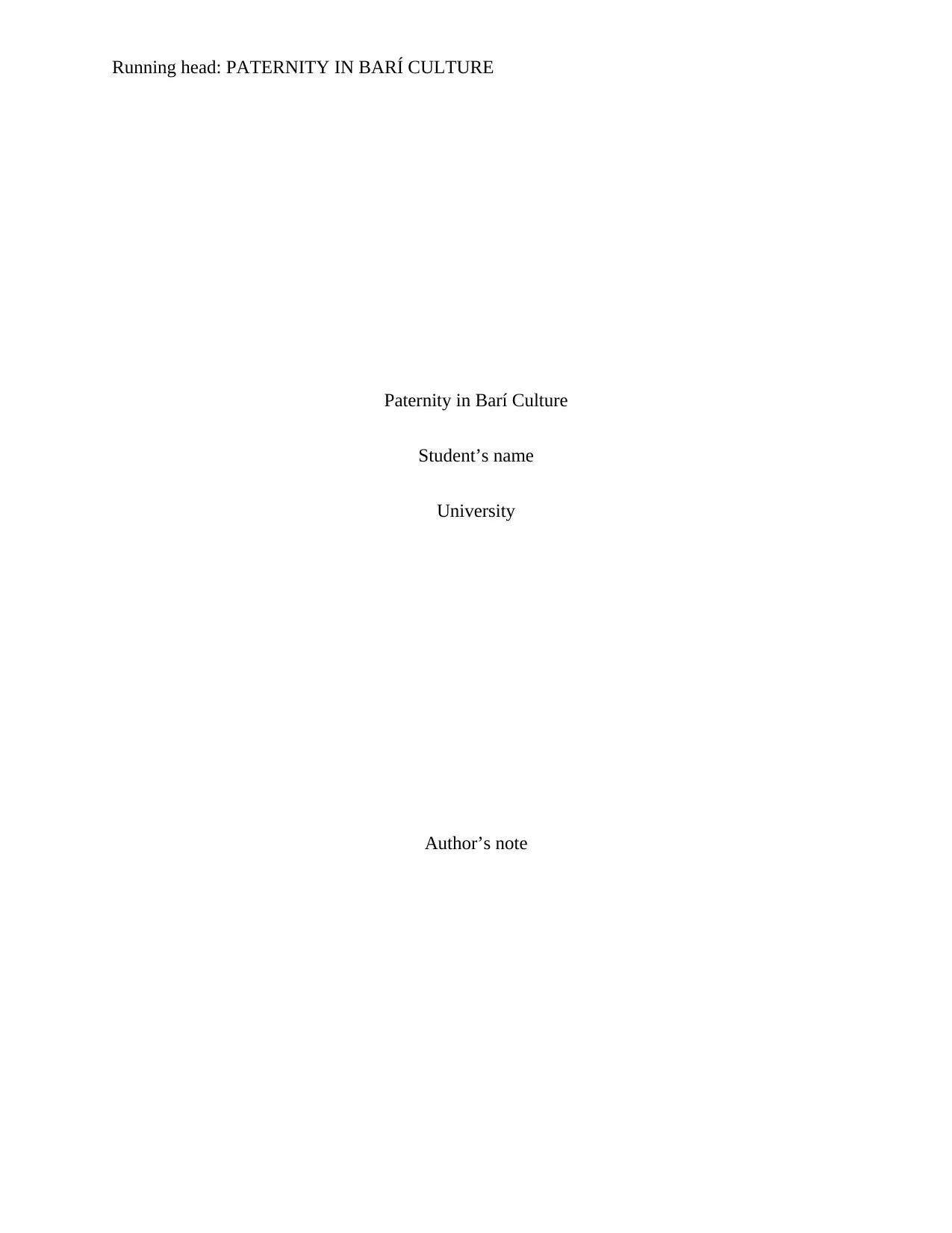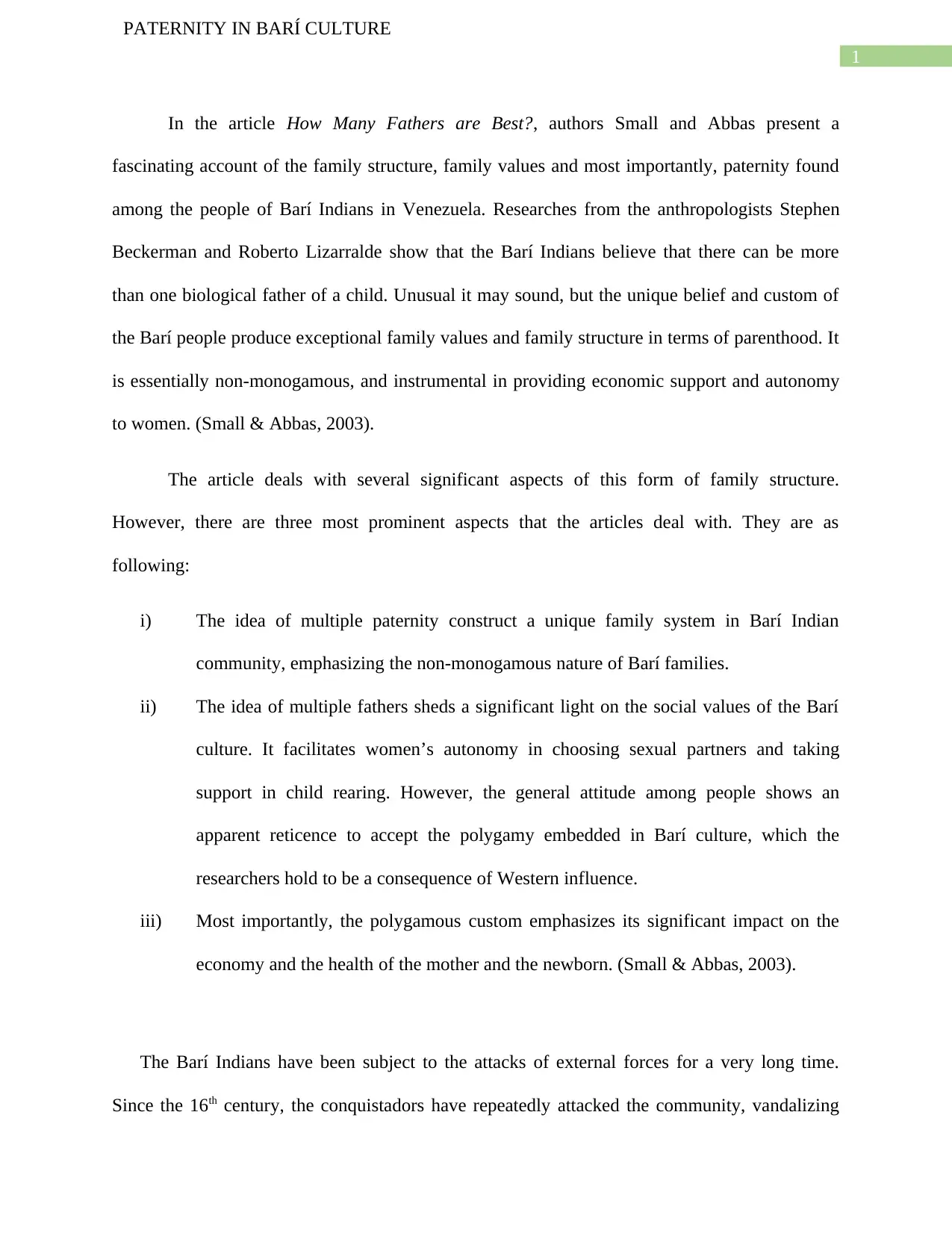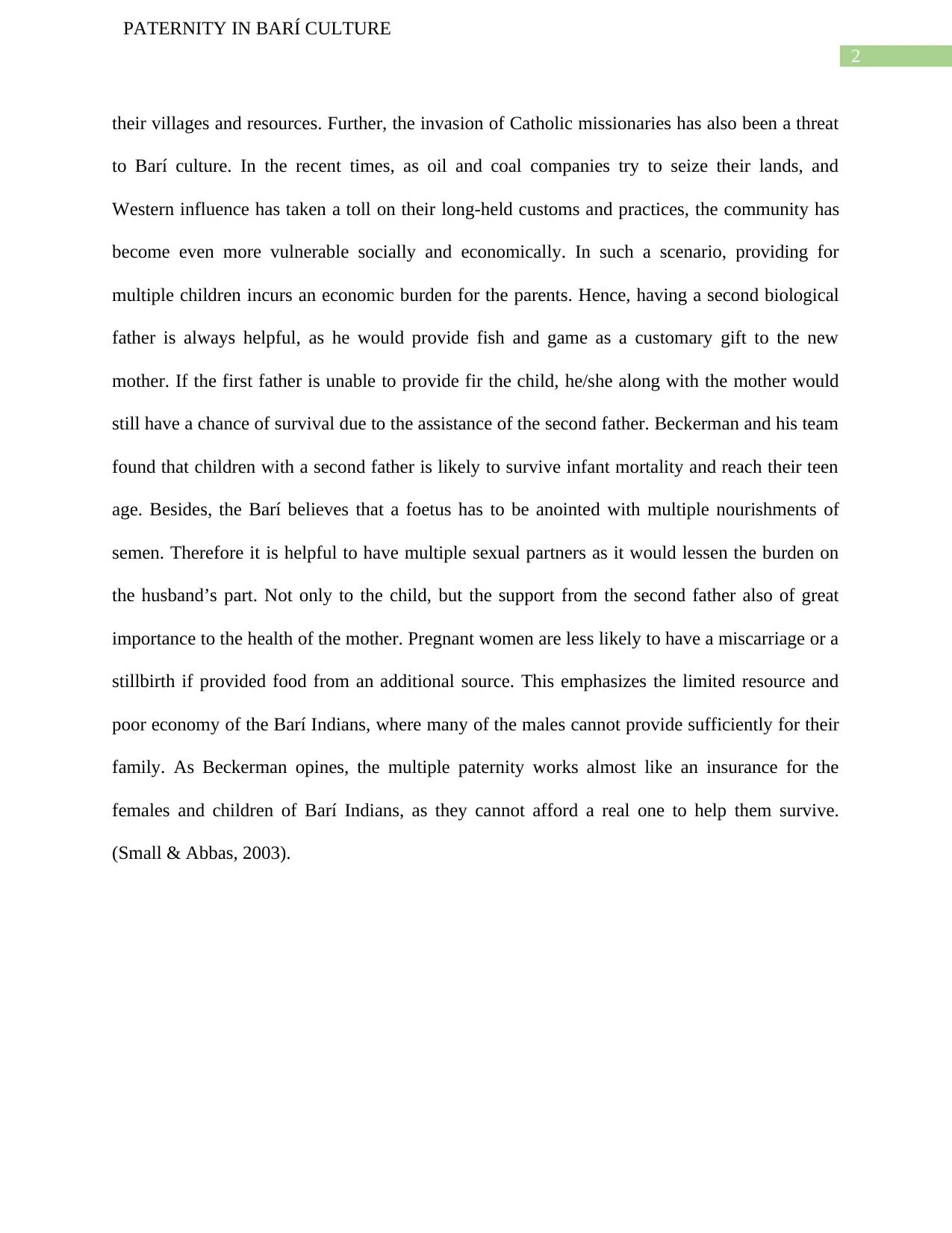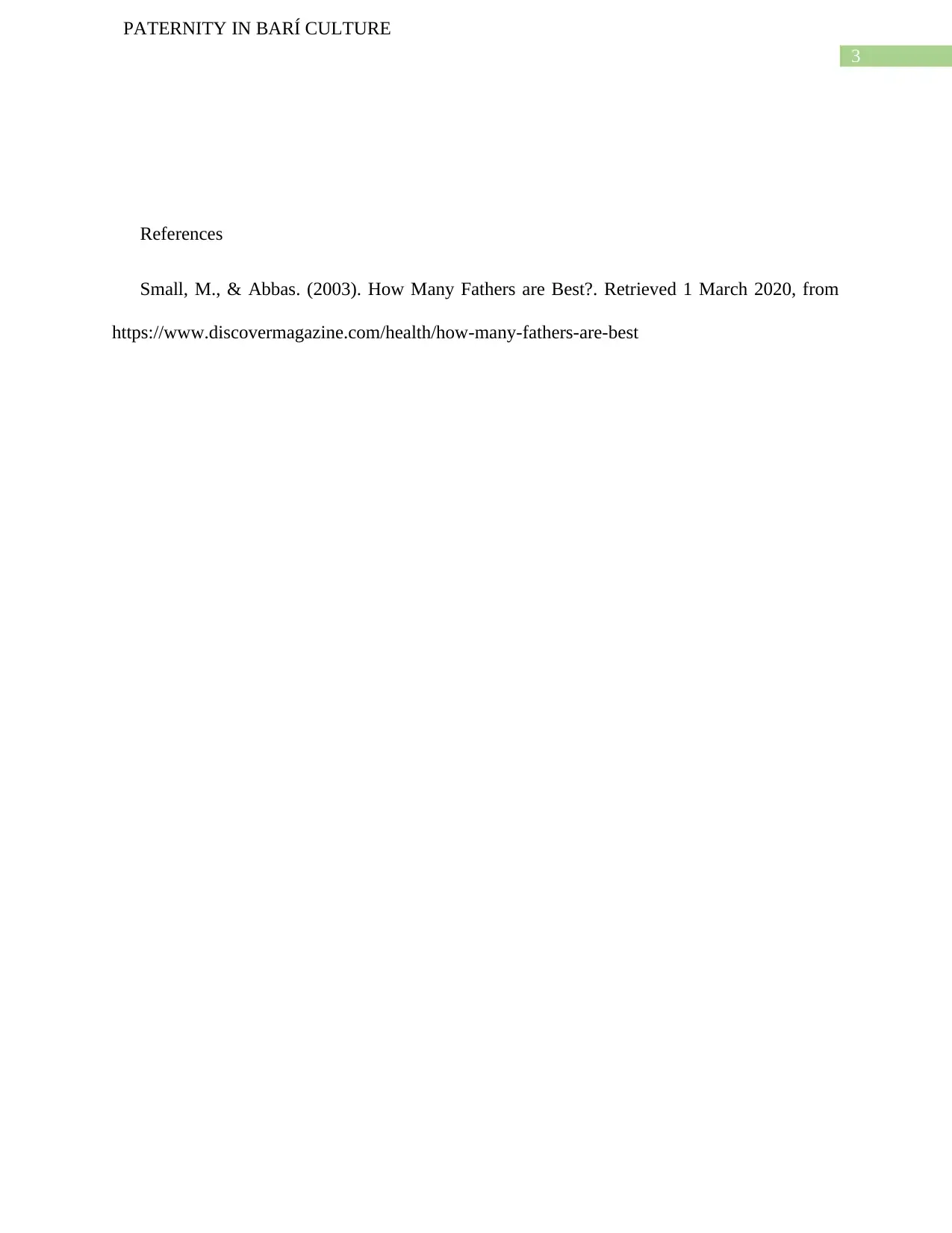Paternit In Bari Culture
VerifiedAdded on 2022/08/15
|4
|677
|18
AI Summary
Contribute Materials
Your contribution can guide someone’s learning journey. Share your
documents today.

Running head: PATERNITY IN BARÍ CULTURE
Paternity in Barí Culture
Student’s name
University
Author’s note
Paternity in Barí Culture
Student’s name
University
Author’s note
Secure Best Marks with AI Grader
Need help grading? Try our AI Grader for instant feedback on your assignments.

1
PATERNITY IN BARÍ CULTURE
In the article How Many Fathers are Best?, authors Small and Abbas present a
fascinating account of the family structure, family values and most importantly, paternity found
among the people of Barí Indians in Venezuela. Researches from the anthropologists Stephen
Beckerman and Roberto Lizarralde show that the Barí Indians believe that there can be more
than one biological father of a child. Unusual it may sound, but the unique belief and custom of
the Barí people produce exceptional family values and family structure in terms of parenthood. It
is essentially non-monogamous, and instrumental in providing economic support and autonomy
to women. (Small & Abbas, 2003).
The article deals with several significant aspects of this form of family structure.
However, there are three most prominent aspects that the articles deal with. They are as
following:
i) The idea of multiple paternity construct a unique family system in Barí Indian
community, emphasizing the non-monogamous nature of Barí families.
ii) The idea of multiple fathers sheds a significant light on the social values of the Barí
culture. It facilitates women’s autonomy in choosing sexual partners and taking
support in child rearing. However, the general attitude among people shows an
apparent reticence to accept the polygamy embedded in Barí culture, which the
researchers hold to be a consequence of Western influence.
iii) Most importantly, the polygamous custom emphasizes its significant impact on the
economy and the health of the mother and the newborn. (Small & Abbas, 2003).
The Barí Indians have been subject to the attacks of external forces for a very long time.
Since the 16th century, the conquistadors have repeatedly attacked the community, vandalizing
PATERNITY IN BARÍ CULTURE
In the article How Many Fathers are Best?, authors Small and Abbas present a
fascinating account of the family structure, family values and most importantly, paternity found
among the people of Barí Indians in Venezuela. Researches from the anthropologists Stephen
Beckerman and Roberto Lizarralde show that the Barí Indians believe that there can be more
than one biological father of a child. Unusual it may sound, but the unique belief and custom of
the Barí people produce exceptional family values and family structure in terms of parenthood. It
is essentially non-monogamous, and instrumental in providing economic support and autonomy
to women. (Small & Abbas, 2003).
The article deals with several significant aspects of this form of family structure.
However, there are three most prominent aspects that the articles deal with. They are as
following:
i) The idea of multiple paternity construct a unique family system in Barí Indian
community, emphasizing the non-monogamous nature of Barí families.
ii) The idea of multiple fathers sheds a significant light on the social values of the Barí
culture. It facilitates women’s autonomy in choosing sexual partners and taking
support in child rearing. However, the general attitude among people shows an
apparent reticence to accept the polygamy embedded in Barí culture, which the
researchers hold to be a consequence of Western influence.
iii) Most importantly, the polygamous custom emphasizes its significant impact on the
economy and the health of the mother and the newborn. (Small & Abbas, 2003).
The Barí Indians have been subject to the attacks of external forces for a very long time.
Since the 16th century, the conquistadors have repeatedly attacked the community, vandalizing

2
PATERNITY IN BARÍ CULTURE
their villages and resources. Further, the invasion of Catholic missionaries has also been a threat
to Barí culture. In the recent times, as oil and coal companies try to seize their lands, and
Western influence has taken a toll on their long-held customs and practices, the community has
become even more vulnerable socially and economically. In such a scenario, providing for
multiple children incurs an economic burden for the parents. Hence, having a second biological
father is always helpful, as he would provide fish and game as a customary gift to the new
mother. If the first father is unable to provide fir the child, he/she along with the mother would
still have a chance of survival due to the assistance of the second father. Beckerman and his team
found that children with a second father is likely to survive infant mortality and reach their teen
age. Besides, the Barí believes that a foetus has to be anointed with multiple nourishments of
semen. Therefore it is helpful to have multiple sexual partners as it would lessen the burden on
the husband’s part. Not only to the child, but the support from the second father also of great
importance to the health of the mother. Pregnant women are less likely to have a miscarriage or a
stillbirth if provided food from an additional source. This emphasizes the limited resource and
poor economy of the Barí Indians, where many of the males cannot provide sufficiently for their
family. As Beckerman opines, the multiple paternity works almost like an insurance for the
females and children of Barí Indians, as they cannot afford a real one to help them survive.
(Small & Abbas, 2003).
PATERNITY IN BARÍ CULTURE
their villages and resources. Further, the invasion of Catholic missionaries has also been a threat
to Barí culture. In the recent times, as oil and coal companies try to seize their lands, and
Western influence has taken a toll on their long-held customs and practices, the community has
become even more vulnerable socially and economically. In such a scenario, providing for
multiple children incurs an economic burden for the parents. Hence, having a second biological
father is always helpful, as he would provide fish and game as a customary gift to the new
mother. If the first father is unable to provide fir the child, he/she along with the mother would
still have a chance of survival due to the assistance of the second father. Beckerman and his team
found that children with a second father is likely to survive infant mortality and reach their teen
age. Besides, the Barí believes that a foetus has to be anointed with multiple nourishments of
semen. Therefore it is helpful to have multiple sexual partners as it would lessen the burden on
the husband’s part. Not only to the child, but the support from the second father also of great
importance to the health of the mother. Pregnant women are less likely to have a miscarriage or a
stillbirth if provided food from an additional source. This emphasizes the limited resource and
poor economy of the Barí Indians, where many of the males cannot provide sufficiently for their
family. As Beckerman opines, the multiple paternity works almost like an insurance for the
females and children of Barí Indians, as they cannot afford a real one to help them survive.
(Small & Abbas, 2003).

3
PATERNITY IN BARÍ CULTURE
References
Small, M., & Abbas. (2003). How Many Fathers are Best?. Retrieved 1 March 2020, from
https://www.discovermagazine.com/health/how-many-fathers-are-best
PATERNITY IN BARÍ CULTURE
References
Small, M., & Abbas. (2003). How Many Fathers are Best?. Retrieved 1 March 2020, from
https://www.discovermagazine.com/health/how-many-fathers-are-best
1 out of 4
Your All-in-One AI-Powered Toolkit for Academic Success.
+13062052269
info@desklib.com
Available 24*7 on WhatsApp / Email
![[object Object]](/_next/static/media/star-bottom.7253800d.svg)
Unlock your academic potential
© 2024 | Zucol Services PVT LTD | All rights reserved.